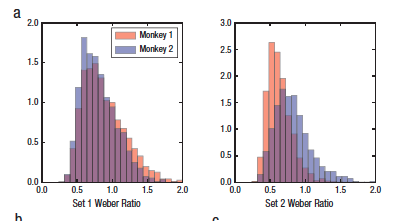Weber’s Law expresses a general relationship between an initial stimulus, a quantity or intensity, and the increased stimulus required for a change in the stimulus to be detected.
The task is to tell apart, or discriminate, two things that differ by only a slight amount.
Weber’s original 1834 observation was that if you are judging if two objects differ in weight, then two heavy objects must differ by a greater amount than two lighter ones if a difference in weight is to be detected. That is heavier weights are harder to discriminate than lighter ones.
The ability to easily discriminate two numbers increases with the numerical distance between them. We react more quickly and make fewer mistakes the greater the distance is between the numbers being compared. This is the distance effect.
So it is easier to compare 2 and 8 (on the left) than it is to compare 8 and 9 (on the right), with separation distances of 6 (8 – 2) and 1 (9 – 8) respectively.
If the distance between the two numbers remains the same then it is easier to compare two small numbers than it is to compare two larger numbers. This is the size effect.
So it is easier to compare 3 and 4 (on the left) than it is to compare 8 and 9 (on the right), both comparisons having a separation distance of 1 (4 – 3 and 9 – 8 respectively).
The Just Noticeable Difference
The just noticeable difference, or difference threshold, is the least amount that a stimulus needs to be changed by, in order to produce a noticeable variation in the sensory experience that the stimulus is producing.
Weber’s Law states that the just noticeable difference is a constant fraction of the stimulus intensity.
ΔI = Kw×I
Where ΔI is the just noticeable intensity difference, Kw is a constant factor (the Weber factor) and I is the stimulus intensity.
Example 1: 3-Day-Old Chick Experiments details here
In the first experiment 3-day-old chicks were trained on the number 5 and then exposed to the numbers 2 and 8, that is to numbers at equal numerical distances from the training value 5 (5 – 2 = 3 and 8 – 5 = 3). Similarly in the second experiment the training value was 20 and the chicks were exposed to the numbers 8 and 32, equally distant from the trained value 20 (20 – 8 = 12 and 32 – 20 = 12).
In both cases avoiding results being contaminated by the distance effect.
Example 2 Jevons’es Data details here
In 1871 the early economist and logician William Stanley Jevons published an article in Nature “The Power of Numerical Discrimination” (Jevons 1871)
Jevons’es experimental procedure was to casually throw black beans at a 4½” diameter white target and then:-
At the very moment when the beans came to rest, their number was estimated without the least hesitation, and then recorded together with the real number obtained by deliberate counting”
Jevons concluded that for him the absolute limit of discrimination was 4, but recognised that the limit probably varied for other people and might perhaps be taken as 4½ if that made any sense.
His estimate corresponds fairly accurately to modern estimates of the subitising range for randomly located dots. See Subitising.
Jevon’s data corresponds to Weber’s Law with accuracy getting worse as set size increases.
ΔN = (N – 4½) ⁄ 9
Where ΔN is the numerical error, 4½ is the limit of discrimination and the offset on the set size axis and the Weber Fraction is 1 ⁄ 9.
Example 3:Bayesian Analysis details here
When baboons watch peanuts being counted into an opaque cylinder and then some more into a second cylinder, they move towards the second cylinder when it begins to have more peanuts in it than the first cylinder.
The Bayesian analysis of this switching behaviour proposes a parameterised model and uses data to infer a probability distribution for the value of each parameter.
The analysis recovers Weber fractions from the switch trials that are similar to the Weber fraction obtained with simple fits across all the trials, although the wide variability of these values is consistent with non-exact representations of the quantities in the first and second cylinders.
Fechner’s Law or Scale
In 1860 Fechner proposed an extension to Weber’s Law. This states that as the stimulus intensity increases, it takes greater and greater changes in intensity to change the perceived magnitude by some constant amount.
S = k log(I)
Where S is the perceived magnitude, k is a modality and dimension constant and I is the stimulus intensity.
Applicability
Weber’s Law is applicable to a variety of sensory modalities (brightness, loudness, mass, line length, etc.). The value of the Weber fraction varies across these modalities but tends to be relatively constant within any particular modality.
It tends to be inaccurate for extremely small or extremely large stimuli values.
The concept of a just noticeable difference (JND) has commercial applications. For instance to ensure that negative changes (reduction in product size or increases in price) remain below the JND and are not apparent to customers. Or so that product improvements (better packaging, larger size or lower price) are apparent to customers but are not too wastefully expensive to produce. That is that they are at or just above the JND.
Bibliography
Cantlon, J. F., Piantadosi, S. T.,Ferrigno, S., Hughes, K. D.,Barnard, A. M. (2015) The Origins of Counting Algorithms. Psychological Science 1-13
Gelman, A., Carlin, J. B., Stern, H. S., Dunson, D. B., Vehtari, A., & Rubin, D. B. (2013).Bayesian data analysis (3rd ed.). Boca Raton, FL: CRC Press.
Jevons, W.S., (1871) The Power of Numerical Discrimination Nature, Thursday February 9, 1871.
Regani R., Vallortigara G., Priftis K., & Regolin L. (2015) Number-space mapping in the newborn chick resembles humans’ mental number line Science. DOI:10.1126/science.aaa1379





